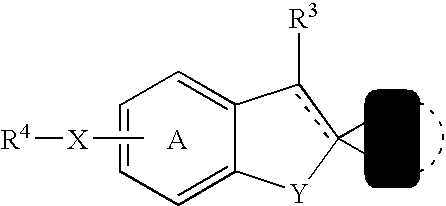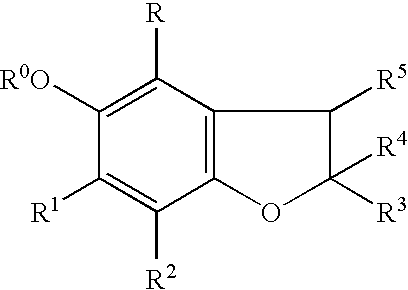Benzofurans as suppressors of neurodegeneration
a technology of neurodegeneration and benzofurans, which is applied in the field of heterocyclic compounds, can solve the problems of degeneration, death, and loss of potency of many types of nerve cells, and no one has yet confirmed the effect of many types of nerve cells, and achieves excellent suppressive effect on neurodegeneration, low toxicity, and excellent permeability to the brain
- Summary
- Abstract
- Description
- Claims
- Application Information
AI Technical Summary
Benefits of technology
Problems solved by technology
Method used
Image
Examples
reference example 1
Methyl α-bromophenylacetate
[0303]Concentrated sulfuric acid (0.5 mL) was added to a solution of α-bromophenylacetic acid (3.00 g, 13.9 mmol) in ethanol (30 mL) at room temperature, and the mixture was heated under reflux for 1 hour. The reaction mixture was cooled, and extracted twice with ethyl acetate. The organic layers were combined, washed with an aqueous saturated sodium hydrogencarbonate, then dried over magnesium sulfate, filtered, and concentrated under reduced pressure to obtain the title compound (2.50 g, yield 79%). This was oily.
[0304]1H-NMR (CDCl3) δ: 3.78 (3H, s), 5.36 (1H, s), 7.29-7.42 (3H, m), 7.48-7.61 (2H, m).
reference example 2
1-Bromo-4-(4-morpholinyl)benzene
[0305]Bromine (10.8 g, 67.4 mmol) was added to a solution of 4-(4-morpholinyl)benzene (10.0 g, 61.3 mmol) in ethanol (100 mL) at 0° C., and the mixture was stirred for 1 hour at room temperature. Water (100 mL) was poured into the reaction mixture, which was then extracted twice with ethyl acetate. The organic layers were combined, washed with an aqueous saturated sodium hydrogencarbonate and water, then dried over magnesium sulfate, filtered, and concentrated under reduced pressure. The residue was crystallized from ethyl acetate-hexane to obtain the title compound (10.7 g, yield 72%).
[0306]m.p.: 118-120° C.
[0307]1H-NMR (CDCl3) δ: 2.98-3.22 (4H, m), 3.71-3.92 (4H, m), 6.72-6.83 (2H, m), 7.31-7.42 (2H, m).
reference example 3
1-Bromo-4-(4-methyl-1-piperazinyl)benzene
[0308]Sodium hydride (60% liquid paraffin dispersion, 2.70 g, 67.8 mmol) was added to a solution of 1-phenylpiperazine (10.0 g, 61.6 mmol) in N,N-dimethylformamide (80 mL) at 0° C., and the mixture was stirred for 10 minutes at the same temperature. To the reaction mixture was added Iodomethane (8.74 g, 67.8 mmol), and the mixture was stirred for 30 minutes at room temperature. The reaction mixture was poured into water (80 mL), and extracted twice with ethyl acetate. The organic layers were combined, washed with water, dried over magnesium sulfate, filtered, and concentrated under reduced pressure. The residue was crystallized from hexane-isopropyl ether to obtain 1-methyl-4-phenylpiperazine (7.40 g). Bromine (7.00 g, 43.8 mmol) was added to a solution of this compound in ethanol (80 mL) at 0° C., and the mixture was stirred for 1 hour at room temperature. Water (80 mL) was poured into the reaction mixture, which was then extracted twice wit...
PUM
| Property | Measurement | Unit |
|---|---|---|
| Fraction | aaaaa | aaaaa |
| Fraction | aaaaa | aaaaa |
| Fraction | aaaaa | aaaaa |
Abstract
Description
Claims
Application Information
 Login to View More
Login to View More - R&D
- Intellectual Property
- Life Sciences
- Materials
- Tech Scout
- Unparalleled Data Quality
- Higher Quality Content
- 60% Fewer Hallucinations
Browse by: Latest US Patents, China's latest patents, Technical Efficacy Thesaurus, Application Domain, Technology Topic, Popular Technical Reports.
© 2025 PatSnap. All rights reserved.Legal|Privacy policy|Modern Slavery Act Transparency Statement|Sitemap|About US| Contact US: help@patsnap.com



